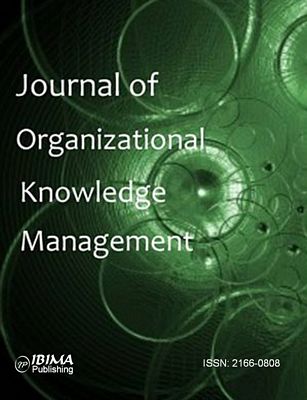Introduction
Knowledge management (KM) is a useful application in devising the unknown from the known. With its systematic and structured processes, such as build, compile, organize, transform, transfer, pool, apply, and safeguard knowledge (Dalkir 2005). KM facilitates the discovery of new knowledge in the variety of forms such as patterns, affinities, forecasts (Dalkir 2005 pp40; Momeni, Fathian & Peyman, 2012) in which the discovery is beneficial for organizational decision making purpose that eventually leads to the improvement of organizational performance.
In Malaysia’s context, the KM knowledge transfer and sharing processes are a concern of local policymakers. One of the main bases of the Malaysia’s Vision 2020 is to transform the country into knowledge based economy (Economic Planning Unit, 2013) by capitalizing information, innovation and intellectual capital in enhancing the country’s development (Dindire & Ioan-Franc, 2012). Through the Malaysia Higher Education Blueprint, the Ministry of Higher Education (MOHE) Malaysia had outlined 10 initiatives that include the collaboration (transfer and sharing) among Malaysian local educational entities (Ministry of Education Malaysia, 2015). The inter-universities and intra-universities collaborations on tacit and explicit academic matters and academic resources are aimed at putting Malaysia as an educational hub in which, in turn, it will enable the country to compete in the global economy.
The Malaysian MOHE initiative is the concern of the research universities (RU). This is because the research, development and commercialization collaborations have been the key activities of Malaysia research universities (RU) namely University of Malaya (UM), Universiti Kebangsaan Malaysia (UKM), Universiti Putra Malaysia (UPM) and Universiti Sains Malaysia (USM) and Universiti Teknologi Malaysia (UTM) (Amran, Rahman, Salleh, Ahmad, & Haron, 2014; M. Y. Cheng, Hen, Tan, & Fok, 2013; Ramli et al., 2013). The RUs are defined upon the national recognition and the outstanding research activities and education based on research and development (R&D) by these universities.
The inter-universities’ and intra-universities’ research, development and commercialization collaborations were established in many extents such as journal publications, supervisions and research grants. However, knowledge transfer through research collaboration may occur in different circumstances involving different levels of participations (inter-universities and intra-universities) that make it difficult to determine the knowledge transfer through the research collaboration. Yet, the type of authorship collaboration that has been carried out in exercising the government’s initiative is scarce in the literature, at least in the Malaysian context.
Studies on research collaboration pattern in Malaysia are limited with only two (2) publications that report the finding on such issue to the date. Yuen & Gan (2014) explored the patterns of co-authorship by identifying the degree and type of research collaboration. They found that, in Malaysia, researchers tend to work in teams, but collaboration is more dominant in science-based research projects than social sciences. Earlier, Kumar (2013) examines research collaborations in Malaysia from the perspective of networks. Using the three essay-based case studies, the topological property of networks is investigated using social network analysis. Kumar’s (2013) report ended up proposing an effective co-authorship strategy and a method to detect academic communities. The research reported in this paper is identical to Yuen and Gans’ (2014) work, but it uses the social network analysis (SNA) approach where the earlier work applied simple statistical tools to identify the degree and type of collaboration.
This paper reports the outcome of the study on the authorship collaboration pattern within the five Malaysian RUs. In general setting, the co-authorship collaboration pattern is believed to be directly portraying the knowledge transfer activities of Malaysia RUs aligned with national agenda. In the Malaysian context, this study is an effort in examining the status of authorship collaborations in Malaysia as it is an indicator for knowledge transfer and sharing. The examining of the authorship pattern will be made using the social network analysis (SNA) technique. The SNA is an analytical tool for understanding research collaboration activities (Lee 2012; Asimenia 2014). The structural dimension of the SNA technique that include degree centrality, betweenness centrality, and closeness centrality allows a proper understanding on how academicians (inter-universities and intra-universities) collaborate with each other by its focus on the links characteristics between the nodes of collaborations.
The remaining parts of this paper are arranged as follows. The next section presents the review that encompasses knowledge management, knowledge transfer in the context of Malaysian authorities, transfer and collaboration within Malaysian RU and the co-authorship collaborations. The following section presents the framework of the study by first outlining the SNA. Section 4 describes the methods that this study applies. The result and analysis occupy the discussion in section 5 and section 6 concludes the paper.
Literature Review
The review of literature is arranged to encompass the components of knowledge management processes, knowledge transfer in the context of Malaysian authorities, the transfer and collaboration within Malaysian RU and the co-authorship collaborations. These components are the body of knowledge build up in this study.
Knowledge Management, Knowledge Transfer and Knowledge Sharing
As its name reveals, KM heavily deals with knowledge. From the process point of view, KM offers a wide range of schematic processes in manipulating organizational information and knowledge into forms useful for organizational decision making purposes. Simply put, KM is the generation, representation, storage, transfer, transformation, application, embedding, and protecting of organizational knowledge (Schultze & Leidner 2002; Morum 2005). Through the schematic processes, organizational knowledge, be it in individual or group and tacit or explicit, can be manipulated and used collaboratively. This in turn will enable the organization to sustain in the long term.
By the benefits that it offers, organizations throughout the globe extensively instantiate KM initiatives in a wide spectrum of organizational business units. The instantiations of KM initiatives may have been emphasizing on some selected processes rather than considering the entire KM processes. For example, IBM and Xerox Corporation had transformed corporate databases and information into useable formats that are readily shared and accessed. As McCune (1999) and Smith (2001) reported, the sharing and accessing initiatives in these two multinational corporations had successfully cut proposal-writing time from an average of 200 hours to 30 hours. In elaborating the organizational knowledge sharing initiative, Smith (2001) cited Liss’s (1999) argument that KM is a formal, directed process of determining what information a company has that could benefit others in the company and then devising ways to making it easily available. While the initiative and Liss’s phrase may inform many learnings, it is clear that the sharing and transfer of organizational knowledge and resources are among the keys for organizational success.
Knowledge Transfer in Malaysia Educational Setting
Knowledge transfer and sharing was a concern of Malaysia’s policymakers as it has direct influence on the nations’ target to achieve developed nation status by 2020. In 2010, the Malaysian government launched the New Economic Model (NEM) with robust economic reform policies due to inadequate innovation and creativity underpinning local economic growth (Ahmad, S. S 2012). In 2014, the Ministry of Higher Education (MOHE), Malaysia introduced Malaysia Higher Education Blueprint outlining 10 main strategies in creating competitive and world’s leading higher education system capable of making Malaysia competent in the global economy (Ministry of Education Malaysia, 2015). The governmental initiative essentially the strategic educational performance with knowledge sharing and transfer is considered.
The range of knowledge transfer activities in the RUs is broad. Generally, in the HEIs, the initiatives and activities related to knowledge transfer could be between individual researcher, groups of researchers and departments in producing research outcomes, authoring research finding, consultation project for third party customers, and collaborate with others to develop something impactful (Lavis et al., 2003). Based on the impactful outcome of collaboration and knowledge transfer, and aligned with this strategic aim of educational system and performance, the government had identified five (5) Malaysia’s public universities as research universities (RU) with aim at boosting up research and innovation initiatives. The “appointment” of University of Malaya (UM), Universiti Kebangsaan Malaysia (UKM), Universiti Putra Malaysia (UPM) and Universiti Sains Malaysia (USM) and Universiti Teknologi Malaysia (UTM) as the RUs is after their focus and commitment on research activities and education-based research and development (R&D) (Amran, Rahman, Salleh, Ahmad, & Haron, 2014; M. Y. Cheng, Hen, Tan, & Fok, 2013; Ramli et al., 2013).
Research and development, as well as commercialization are clearly the key concerns in these Malaysian RUs prior to the official appointment. In order for the Malaysian RUs, as the higher education institutions (HEIs), to stay competitive, the collaboration with external research agencies either from the government or private industry (Cantor, Bolumole, Coleman, & Frankel, 2010; Guimera, 2005) is inevitable. The collaboration with external research agencies and industries is an extended “impulse” by maintaining the inter-universities and intra-universities collaborations. By the new status and industrial collaborative, the government expects these RUs to significantly enhance their research performance, promote collaborative research activity and increase the number of journal publications. The government’s expectation is based upon the goal of becoming the world’s leading higher education system and attracting students’ abroad.
Research Collaboration within Malaysian RUs
Research collaboration is one of the knowledge transfer activities involving the exchange of knowledge among researchers and academicians. In the knowledge intensive institution like RUs, knowledge transfer is highly dependent on effective research collaboration. Working together with inter-universities and intra-universities would be more fruitful as Laylock (2005) acknowledged that collaboration within or across units will add values to the individual apart from it will enable resource and supply sharing between collaborators (Laycock, 2005). Furthermore, knowledge transfer in research collaboration is also widely recognized as an important initiative for new knowledge creation base (Laycock, 2005; Ling et al., 2009). Cantor et al. (2010) stated that collaboration between researchers has been a normal practice for the last 30 years to enhance research productivity in HEI worldwide.
The motivation behind the research collaboration can be explained by several reasons. A study by Cheng et al. (2011) suggests that external and internal motivational factors of economic (Dwivedi & Mustafee 2008; Katz & Martin 1997), social (Choo 2008; Gordon 1980), technological (Heffner 1981; Toral, Bessis, & Martínez-Torres 2013) and legal area (Moed at al. 1991; Nor 2012) are equally important to explain knowledge transfer activities through research collaboration.
Authorship Collaboration and Its Role
One of the research outcomes is the research publication or scholarly publication. The scholarly publications are acknowledged as significant output of research including the collaborative research projects. Through the collaboration effort (as well as non-collaborative effort), the scholarly publications are authorized after several authors. In this sense, the collaborative research members co-authorize the scholarly publications as a well-documented and tangible outcome of the collaborated research project.
The scholarly publication and authorship contributes to individual, units, or institution’s performance. A study by Munoz, Queupil, & Fraser (2016) reveals that scholarly publication has been widely acknowledged as one of the criteria for assessing the reputation of an academic institution. The scholarly publication and authorship therefore play an important role in determining the rank of HEIs as QS World University Rankings and Times Higher Education World Universities Ranking rely on it to evaluate and rank the HEIs across the world (Munoz et al. 2016; Sirat & Ahmad, 2010). Although the evaluation consists of a diverse range of criteria, the scholarly publication carries much value in scoring higher ranking for the institutions (Munoz et al., 2016).
At researcher’s individual level, the joint scholarly publication activities partly indicate knowledge transfer activities within or across the department, either locally or internationally. Abbasi & Altmann (2011) acknowledged that crucial outputs of research and authorship collaboration are the creation of new knowledge such as new research proposals, new research questions, and new theories in which these quantifiable outcomes indicate the existence of knowledge transfer through research collaborations initiatives of researchers (Liu et al., 2005).
The Framework for Measuring Authorship Collaboration
There is no argument about the importance and benefits of research collaboration and the role of the authorship collaborative publications. However, the assessment measures of research collaboration with respect to authorship and scholarly publications are an issue. According to Bukvova (2010), correct assessment tools pertaining to research collaboration activities and the yielded outcomes are the debate among policy makers. The same issue had been raised up by Chinchilla-Rodríguez et. al (2009) in which the nature of research collaboration within or between individuals, units or departments occurs in different dimensions and aspects, and involves different level of collaborations and participations that are hardly assessed.
In resolving the issue, the literature suggests that the research collaboration measured upon the co-authorship of the scholarly publication. Liu, Bollen, Nelson, & Sompel (2005) found that co-authorship is the most adequate technique used by academicians to resolve this issue. The comparative study by Savanur & Srikanth (2010) also found the co-authorship analysis as a most common measure in research collaboration. Based on its adequacy, hence, Cimenler (2014) proposed the use of co-authorship as an indicator of collaboration performance. Zervas, Tsitmidelli, Sampson, Chen, & Kinshuk (2014) pointed out that common metric used in measuring collaboration in research activities include co-authorship publication (concerned with who works with whom) and citation analysis (concerned with who cites who).
In measuring the research collaboration through its co-authorship pattern, a technique known as social network analysis (SNA) (Nahapiet & Ghoshal 1998) has been widely applied. The SNA had been adopted in many studies on collaboration’s theme. For example, Wise (2012) uses SNA to study the effects of intragroup social network relations on group performance. Li, Liao, & Yen (2013) apply the SNA technique to explore the associations among the three dimensions of social capital namely structural, relational and cognitive dimensions and their influence on research impact. Earlier, these dimensions had been used by Nahapiet & Ghoshal (1998).
In the same vein, this study adopts the conceptual framework of social capital theory by Nahapiet & Ghoshal (1998) and operated by Li et al. (2013) to fit the objective of this study. Fig. 1 illustrates the framework of academic authorship collaboration pattern presented in this paper. The structural dimensions depicted in the figure refer to the centrality of ties and links between the authors, while the relational dimensions indicate the links numbers of the authors.
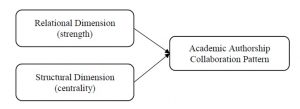
Fig. 1: Proposed Conceptual Framework of Academic Authorship Collaboration Pattern
The unit of analysis for this study is the affinity or relationship of the authorship in which the collective affinities would produce the pattern of the association among the authors. The outcome is the visualized links between academicians, departments, and universities in collaborative authorship activities.
It is important to consider the strength (Relational Dimension) which those connections interact with. The degree to which two ties have a ‘strong’ or ‘weak’ bond cannot be solely attributed to the frequency with which they interact. This is due to that, the frequency of contact may have some correlation with tie strength, but it cannot serve as an all-encompassing substitute for tie strength (Wise, 2012). In this vein, Li et al. (2013) suggested that a plausible way of measuring trust among scholars is to examine whether they had repeated co-authorships. Only through repeated co-authorship then the trustworthy relationship and willingness to share resources can be identified.
The centrality (Structural Dimension) is included in the framework as to measure the distance of an author with other authors in the network. The closer an author is to others, the more favored the author is. Authors with high closeness scores are likely to receive information more quickly than others as there are fewer intermediaries (Day et al., 2011). In this way, the centrality indicates the closeness of favored authors in an entire authorship collaboration examined.
However, this paper limits to present the Structural Dimension or the centrality of the co-authorship rather than the Relational Dimension (strength) of the authorship collaboration. The limitation is due to the fact that reporting both dimensions takes longer discussion space and attention. By this limitation, the reporting of the strength would be made separately in the consecutive publication.
Research Method
This study applies a “sort of” data mining approach for knowledge discovery. In particular, the Cross Industry Standard Process for Data Mining (CRISP-DM) (CRISP-DM 2000; Wirth & Hipp 2000; Niaksu 2015). By “sort of”, the steps of CRISP-DM namely data understanding, data preparation, modeling and evaluation have been adopted. The first and last steps of CRISP-DM i.e. business understanding and deployment respectively are not related with the analytical method and therefore these two steps have been abandoned.
The data used in this study are obtained from Scopus website that indexed the quality publications throughout the globe. The Scopus website indexed and provided vast coverage in various disciplines of academic publications (Bartol, Budimir, Dekleva-Smrekar, Pusnik, & Juznic, 2014) authored by scholars including Malaysia. In this sense, the Scopus data appear to be an appropriate source to study social network analysis of authorship collaboration pattern in Malaysia RUs. In accomplishing the research objectives, the Scopus publications from 2013 through 2015 by Malaysia authors consisting at least one author/researcher from Malaysian’s RU with respective details of the authors’ name, publication date, journals name, affiliation are located. By utilizing advanced search function on Scopus website, the search using the following query;
((AF-ID(“University of Malaya” 60029157) OR AF-ID(“Universiti Putra Malaysia” 60025577) OR AF-ID(“Universiti Sains Malaysia” 60000906) OR AF-ID(“Universiti Kebangsaan Malaysia” 60001821) OR AF-ID(“Universiti Teknologi Malaysia” 60021005) OR AF-ID(“School of Medical Sciences – Universiti Sains Malaysia” 60002512) OR AF-ID(“Faculty of Medicine – Universiti Kebangsaan Malaysia” 60000968) OR AF-ID(“Universiti Teknologi Malaysia Kuala Lumpur” 60090601) OR AF-ID(“University of Malaya Medical Centre” 60013665) OR AF-ID(“Hospital Universiti Kebangsaan Malaysia” 60029395) OR AF-ID(“Hospital Universiti Sains Malaysia” 60020855) OR AF-ID(“Universiti Teknologi Malaysia Faculty of Electrical Engineering” 60014001) OR AF-ID(“Universiti Sains Malaysia Health Campus” 60032354))) AND ( LIMIT-TO(PUBYEAR,2015 ) OR LIMIT-TO(PUBYEAR,2014 ) OR LIMIT-TO(PUBYEAR,2013 ) )
The query above resulted in 49699 hit of Malaysia RUs scholarly articles in the Scopus database. The attributes or metadata of the articles are downloaded into a comma separated value (*CSV) format that can be read in Microsoft Office. The data pre-processing is performed to prepare the data for use in the data mining process which involved data cleaning and data formatting. This is done to ensure the data are fit to be analyzed and modeled. Data cleaning and transformation yielded 48,239 co-authorized publications fit for use. The final data containing the authors’ detail and affiliation are taken into Gephi social network analysis software where the modeling is carried out. Using Gephi wizard, network visualization network is produced for further analysis.
The measurement of numerous characteristics and properties of networks is the most important tool for analysis and understanding. Based on proposed research framework, the SNA model is analyzed in both structural and relational dimensions. Nodes in the network represent authors whereas edge is the number of collaboration occurred between authors. The data laboratory function in Gephi software is utilized to calculate the statistics needed to accomplish the objective of the study. The production of the authorship pattern is made using the OpenOrd value setting to 0.6 of Edge Cut, 10 Num Treads, 12000 Num Iterations and 0.5 Fixed Time. The default value for Random seed is 3852999678204122445. Fig. 2 displays the setting of the layout.
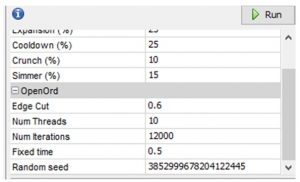
Fig. 2: Gephi OpenOrd configuration setting
The Result and Analysis
The result for analysis of co-authorship patterns is presented in accordance to the variables identified in the framework of the study. The structural dimension intended in this study is the author’s centrality from the whole network and it includes three centralities measures namely degree centrality, betweenness centrality, and closeness centrality.
The Co-Authorship Pattern
The patterns of the authorship in Malaysia RUs are portrayed in Gephi adopting OpenOrd layout as suggested by Martin, Brown, Klavans, & Boyack (n.d.) for a large network such as produced in this study. The Gephi software processes the Scopus data containing 48,239 authors. In the view of SNA, the numbers are reduced 9985 nodes and 214036 edges. The pattern of structural dimension of the co-authorship data produced by Gephi is shown in Fig. 3.
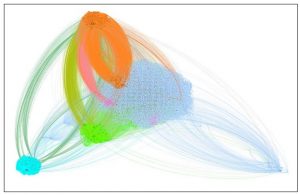
Fig. 3: RUs Authorship Pattern
Structural Dimension
The structural dimension i.e. the centrality of authors is analyzed in order to gain a better understanding about the authorship collaboration pattern in Malaysia RUs. The structural dimension of this study is the author’s centrality from the whole network. There are 3 centralities measurer used: degree centrality, betweenness centrality, and closeness centrality as shown in Fig. 4
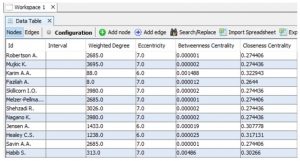
Fig. 4: Gephi Data Laboratory for nodes
Degree Centrality
Degree centrality is the number of linked nodes connected to the node. In authorship collaboration pattern, degree centrality represents the number of authors that collaborated with an author over the period of time regardless of the number of published papers by the author. According to Gephi result, the average degree of all authors is 11.687. The top 10 authors with the highest average degree are presented in Fig. 5. In fact, 13 authors out of the 20 top authors are from UM. Conversely, none of the authors are from USM. Additionally, the 8 top rank authors from UM have degree value more than 300 compared to other authors with less degree than them.

Fig. 5: Top 10 authors with the highest degree centrality
Betweenness Centrality
Betweenness Centrality defines the co-authorship network in which authors with high betweenness centrality are in a favored position (Kumar, 2013). Gephi generated this value automatically and named it as betweenness centrality. The Closeness Centrality rests on how close an author is to all others in the network. An author with high betweenness centrality can be considered as an important person in bridging and connect another author from a different part of the network. Briefly, betweenness centrality is defined as an author in a position where other authors are connected through him or her.
Fig. 6 displays 20 top authors with the highest betweenness centrality with Ahmad S. from UKM at the top (0.0196 betweenness centrality value). The table shows that a person with the highest degree of centrality is not necessarily the highest in betweenness centrality measure. In fact, the highest centrality measures author, Ahmad S. ranked 14th in the degree centrality ranking. It can be seen that an author from USM (Ismail Z.) appears in the list although he is not listed in the degree centrality top list. In comparison, the list of the top 20 authors with the highest betweenness centrality in the Malaysian RUs are seven authors from UM, six authors from UKM, four authors from UTM, two authors from USM and one author from UPM.
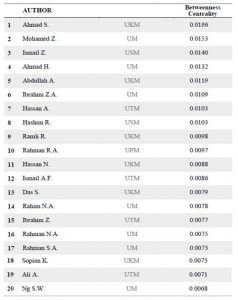
Fig. 6: Top 20 authors with highest betweenness centrality
Closeness Centrality
The premise of closeness centrality rests on how close an author is to all other authors in the network (Kumar, 2013). Closeness centrality is another measure in the structural dimension of social network analysis to analyze the closeness of an author with all authors in the entire network. High closeness centrality indicates the influence of the author towards the network. The top 20 authors with the highest closeness centrality are tabulated in Fig. 7. Notice that an author with high betweenness centrality does not necessarily also have high closeness centrality value. While the list of the top 20 authors with the highest betweenness centrality measures is the same as the list in closeness centrality, the subsequent authors are different. Therefore, the differences in both lists need further analysis to understand the important and crucial role of the author in shaping the pattern in the entire network of authorship collaboration of Malaysia research universities.

Fig. 7: Top 20 authors with highest closeness centrality
Discussion and Finding
The structural dimension pattern of authorship collaboration generated from Scopus database had been analyzed using SNA approach in a comprehensive and systematic manner. The analysis of the structural dimension as in the research framework involves the social network in terms of the number of relationship links in the network which maps the degree of centrality of each author. One of the most practical uses of social network analysis is to identify the key players in a network. According to Bordons, Aparicio, González-Albo, & Díaz-Faes (2015), centrality helps determine the key players, or the most prominent members of a network, a central figure where any strategic change must start from it.
Centrality Degree measures the number of lines that most connected to a node. Authors with high degree centrality are those that have most collaborations. Using this measure, the most active and influential authors in the entire network are identified. The centrality degree measures of Malaysian RUs authorship collaboration demonstrate that the top 8 authors with the highest collaboration network within the year 2013 to 2015 are from UM. The collaborators Ibrahim Z.A., Omar S.Z., Wan Abdullah W.A.T., Woo Y.L., Zolkapli Z., Rahman N., Mohamad Idris F., and Taib N.A.M. gained more than 300 degrees each whereas the 9th ranked authors are at 284 degrees. This wide disparity in degree range indicates that at the university level, UM has the highest collaboration network compared to another RUs. This happens possibly because the UM has a high reputation as the oldest university in Malaysia among HEIs and thus attracts other researchers to collaborate with researchers from UM. Besides, this degree centrality value measure does not consider the arrangement of the authors in the publication of the paper as there are many factors leading to the inclusion of authors’ names in a publication.
The betweenness and closeness centrality analysis show that Ahmad S. (UKM), Mohamed Z. (UM), Ismail Z. (USM), Ahmad H. (UM), and Abdullah A. (UKM) are important authors for authorship collaboration network of RUs as they have the highest value for both closeness and betweenness centrality analysis. It can be concluded that these 5 authors are the closest middlemen of the authorship flow in Malaysian RUs. Generated findings also illustrate the broader view on the current authorship collaboration trend in Malaysia RUs. The top authors in the same betweenness and closeness centrality portray the dominant prolific authors among the authors in RUs. The 5 top academicians from 3 different universities imply that they have a stronger network with another author outside their own universities. In brief, they have high influence over the entire networks and important actors in implementing any new government initiatives regarding academic authorship and research collaborations.
On the other hand, another curious remark that can be made from the structural dimension analysis is that none of the top 5 highest degree centrality is listed in the top 5 authors with the highest betweenness and closeness centrality. This circumstance raised some crucial understanding of the collaboration that has been undertaken by the 5 authors from UM. This is almost certainly a case like what Kumar (2013) raised in his thesis about hyper-authorship. Hyper authorship is a situation where a paper was authored by hundreds or even thousand authors in a single publication (Cronin, 2001). If an author named in or appears in one paper involving hyper-authorship situation, their degree centrality values is high but lower in closeness and betweenness centrality as the number of authors in the paper is plenty. Although this study had already disregarded several papers which involved thousands of authors, but papers with more than hundred numbers of authors still exist.
Moreover, the circumstances likely happened because each university has developed almost all-range of academic discipline independently. Thus, the collaboration across universities motivated by resource sharing (Dwivedi & Mustafee, 2008; Katz & Martin, 1997) or easiness of communication (Hafeez-Baig & Gururajan, 2012) possibly is not influencing factors here in authorship and research collaboration in Malaysia RUs. Based on the results and analysis of the findings, the collaborative authorship in RUs publication is dominant (more than 97%) compared to single authorship publication. This circumstance is probably triggered by the increase of awareness from RUs authors about the advantage of collaboration in authorship for their personal benefits like gaining more knowledge through knowledge transfer activities in the collaboration activities (Alsayed et al., 2012; Cantor et al., 2010) or for the units or departments in improving their MyRA score base on the instrument introduced by Malaysia government (Nor, 2012).
Conclusion
This study is conducted to examine the KM knowledge transfer and sharing processes in Malaysian RUs. The examination is made by analyzing the co-authorship collaboration pattern among researchers in Malaysia Research Universities (RUs). The pattern of authorship collaboration generated from Scopus database containing co-authorship publication data was analyzed using SNA approach in a comprehensive and systematic manner. By applying SNA models and technique, the authorship collaboration networks can be observed. Based on the generated figure, it can be concluded that research knowledge transfer within Malaysia RUs is an active process. Even though the Gephi software does not classify the co-authorship publication collaboration by institutions, the result visualizes the existence of collaboration across the institutions. This indicates that knowledge transfer activities through research collaboration occurred extensively among researchers affiliated with Malaysian RUs.
Acknowledgement
The work described in this paper is supported and made possible by Research Grant Scheme (RAGS) University Teknologi MARA (600-RMI/RAGS 5/3 (4/2015) under the administration of the Institute of Research Management & Innovation (IRMI), Universiti Teknologi MARA, Shah Alam, Selangor, Malaysia.
References
Abbasi, A., Chung, K. S. K. and Hossain, L. (2012). ‘Egocentric analysis of co-authorship network structure, position and performance. Information Processing and Management, 48(4), 671–679. https://doi.org/10.1016/j.ipm.2011.09.001
Ahmad, S. S. (2012). ‘Performance indicators for the advancement of Malaysian research with focus on social science and humanities’. Procedia – Social and Behavioral Sciences, 68, 16–28. https://doi.org/10.1016/j.sbspro.2012.12.203
Amran, F. H., Rahman, I. K. A., Salleh, K., Ahmad, S. N. S. and Haron, N. H. (2014). ‘Funding trends of research universities in Malaysia. Procedia – Social and Behavioral Sciences, 164, 126–134. https://doi.org/10.1016/j.sbspro.2014.11.060
Asimenia, T. (2014). ‘Studying co-authorship networks in the field of technology enhanced learning’. Unpublished Master Thesis. Department of Digital Systems. University of Piraeus. http://dione.lib.unipi.gr/xmlui/bitstream/handle/unipi/6653/Tsitmidelli.pdf?sequence=2
Bartol, T., Budimir, G., Dekleva-Smrekar, D., Pusnik, M. and Juznic, P. (2014). ‘Assessment of research fields in Scopus and web of science in the view of national research evaluation in Slovenia’. Scientometrics, 98(2), 1491–1504. https://doi.org/10.1007/s11192-013-1148-8
Bukvova, H. (2010). ‘Studying research collaboration: a literature review’. Working Papers on Information Systems, 10(2010), 17 pp. https://doi.org/10.2307/3069464
Cantor, D. E., Bolumole, Y., Coleman, B. J. and Frankel, R. (2010). An examination of trends and impact of authorship collaboration in logistics research. Journal of Business Logistics, 31(1), 197–215. https://doi.org/10.1002/j.2158-1592.2010.tb00135.x
Cheng, M. Y., Hen, K. W., Tan, H. P. and Fok, K. F. (2013). ‘Patterns of co-authorship and research collaboration in Malaysia’. ASLIB Proceedings: New Information Perspectives, 65(6), 659–674. https://doi.org/10.1108/AP-12-2012-0094
Choo, K. (2008). ‘Fusion Technology and Its Value: Evidence from Korean Patent’. In 3rd Annual Conference of the EPIP Association (pp. 1–33).
Cimenler, O. (2014). Social network analysis of researchers’ communication and collaborative networks using self-reported data. University of South Florida.
Dalkir, K. (2005). ‘Knowledge management in theory and practice’. United States: Elsevier Butterworth–Heinemann.
Day, M.-Y., Shih, S.-P. and Chang, W. (2011). ‘Understanding scientific collaboration with social network analysis’. The 17th Cross-Strait Conference on Information and Management (CSCIM 2011) (pp. 1–15).
Dindire, L.-M. and Ioan-Franc, V. (2012). Organisational behaviour in the knowledge-based society – a Romanian context approach. Romanian Journal of Economics, 34(1), 112–130. Retrieved from http://revecon.ro/articles/2012-1/2012-1-6.pdf
Dwivedi, Y. K. and Mustafee, N. (2008). Profiling Research Published in the Journal of Enterprise Information Management (JEIM). European Journal of Information Systems, 17(6), 678–693.
Economic Planning Unit. (2013). Wawasan 2020. Retrieved August 14, 2016, from http://www.epu.gov.my/en/wawasan-2020-1991-2020
Gordon, M. D. (1980). A critical reassessment of inferred relations between multiple authorship, scientific collaboration, the production of papers and their acceptance for publication. Scientometrics, 2(3), 193–201. https://doi.org/10.1007/BF02016697
Guimera, R. (2005). Team Assembly Mechanisms Determine Collaboration Network Structure and Team Performance. Science, 308(5722), 697–702. https://doi.org/10.1126/science.1106340
Haythornthwaite, C. (1996). Social network analysis: an approach and technique for the study of information exchange. Library & Information Science Research, 18(4), 323–342. https://doi.org/10.1016/S0740-8188(96)90003-1
Heffner, A. G. (1981). Funded research, multiple authorship, and subauthorship collaboration in four disciplines. Scientometrics, 3(1), 5–12. https://doi.org/10.1007/BF02021860
Joe-Nkamuke, U. (2015). Who is working with whom: Co- authorship and co-citation networks in agricultural economics literature on Central and Eastern Europe. Université Catholique de Louvain. http://sites.uclouvain.be/afepa/wp-content/uploads/2015/07/Uzoamaka-JOE.pdf
Katz, J. S. and Martin, B. R. (1997). What is research collaboration? Research Policy, 26(1), 1–18. https://doi.org/10.1016/S0048-7333(96)00917-1
Kumar, S. (2013). Structure of research collaboration networks – case studies on Malaysia. University of Malaya.
Lavis, J. N., Robertson, D., Woodside, J. M., McLeod, C. B. and Abelson, J. (2003). How Can Research Organizations More Effectively Transfer Research Knowledge to Decision Makers? The Milbank Quarterly, 81(2), 221–248.
Laycock, M. (2005). Collaborating to compete: achieving effective knowledge sharing in organizations. The Learning Organization, 12(6), 523–538. https://doi.org/10.1108/09696470510626739
Li, E. Y., Liao, C. H. and Yen, H. R. (2013). Co-authorship networks and research impact: A social capital perspective. Research Policy, 42(9), 1515–1530. https://doi.org/10.1016/j.respol.2013.06.012
Ling, C. W., Sandhu, M. S. and Jain, K. K. (2009). Knowledge sharing in an American multinational company based in Malaysia. Journal of Workplace Learning, 21(2), 125–142. https://doi.org/10.1108/13665620910934825
Liss, K. (1999), `Do we know how to do that? Understanding knowledge management’’, Harvard Management Update, February, pp. 1-4
Liu, X., Bollen, J., Nelson, M. L. and Sompel, H. Van De. (2005). Co-authorship networks in the digital library research community. Information Processing and Management, 41(6), 1462–1480. https://doi.org/10.1016/j.ipm.2005.03.012
Martin, S., Brown, W. M., Klavans, R. and Boyack, K. (n.d.). OpenOrd: An Open Source Toolbox for Large Graph Layout. Retrieved from http://www.sandia.gov/~smartin/presentations/OpenOrd.pdf
McCune, J.C. (1999), `Thirst for knowledge’’, Management Review, April, pp. 10-12.
Ministry of Education Malaysia. (2015). Malaysia Education Blueprint 2015-2025 (Higher Education). Putrajaya. https://doi.org/10.5923/j.ijis.20120206.05
Moed, H. F., De Bruin, R. E., Nederhof, A. J. and Tijssen, R. J. W. (1991). International scientific co-operation and awareness within the European community: Problems and perspectives. Scientometrics, 21(3), 291–311. https://doi.org/10.1007/BF02093972
Morum, R. S. (2005). A Model for Knowledge Management in an Architectural Enterprise. Unpublished Master Thesis, UNITEC Institute of Technology, New Zealand. http://unitec. researchbank.ac.nz/bitstream/handle/10652/2208/_01-07%20KM%20in%20Architecture.pdf?seq uence=1
Munoz, D. A., Queupil, J. P. and Fraser, P. (2016). Assessing collaboration networks in educational research: A co-authorship-based social network analysis approach. Journal of Educational Measurement, 30(3), 416–436. https://doi.org/10.1108/IJEM-11-2014-0154
Nahapiet, J. and Ghoshal, S. (1998). Social Capital, Intellectual Capital and the Organizational Advantage. Academy of Management Review, 23(2), 242–266.
Niaksu, O. (2015). CRISP Data Mining Methodology Extension for Medical Domain. Baltic Journal of Modern Computing, Vol. 3(2). pp 92-109.
Nor, M. J. M. (2012). The Malaysian experience : A new approach in managing multi-disciplinary research projects. The Academic Executive Brief, 2(2), 10–12.
Ramli, N., Zainol, Z. A., Abdul Aziz, J., Mohd. Ali, H., Hassim, J., Wan Hussein, W. M. H. and Yaakob, N. I. (2013). The concept of research university: The implementation in the context of Malaysian university system. Asian Social Science, 9(5), 307–317. https://doi.org/10.5539/ass.v9n5p307
Savanur, K. and Srikanth, R. (2010). Modified collaborative coefficient: A new measure for quantifying the degree of research collaboration. Scientometrics, 84(2), 365–371. https://doi.org/10.1007/s11192-009-0100-4
Schultze, U. and Leidner, D. “Studying Knowledge Management in Information Systems Research: Discourses and Theoretical Assumptions.” MIS Quarterly, Vol. 26, No. 3, September 2002, pp. 213-242.
Sirat, M. and Ahmad, A. R. (2010). University governance structure in challenging times: the case of Malaysia’s first APEX university (Universiti Sains Malaysia). In K.-H. Mok (Ed.), The search for new governance of higher education in Asia (pp. 124–137). New York: Palgrave Macmillan.
Smith, E. A. (2001). Journal of Knowledge Management Vol. 5(4). pp. 311-321.
The CRISP-DM consortium, (2000). CRISP-DM 1.0. https://www.the-modeling-agency.com/crisp-dm.pdf
Toral, S. L., Bessis, N. and Martínez-Torres, M. D. R. (2013). External collaboration patterns of research institutions using shared publications in the Web of Science. Program: Electronic Library and Information Systems, 47(2), 170–187. https://doi.org/10.1108/00330331311313753
Wirth, R. and Hipp, J. (2000). CRISP-DM: Towards a Standard Process Model for Data Mining. Proceedings of 4th Int. Conf. on the Practical Applications of knowledge discovery and data mining.http://citeseerx.ist.psu.edu/viewdoc/download?doi=10.1.1.198.5133&rep=rep1&type=pdf
Wise, S. (2012). The Impact of intragroup Social Network Topology on Group Performance: Understanding intra-organizational Knowledge Transfer through a Social Capital Framework. University of Glasgow. Retrieved from http://theses.gla.ac.uk/3793/1/2012WisePhD.pdf
Zervas, P., Tsitmidelli, A., Sampson, D. G., Chen, N. S. and Kinshuk. (2014). Studying research collaboration via co-authorship analysis in the field of TeL: The case of educational technology & society journal. Educational Technology & Society, 17(4), 1–16.



